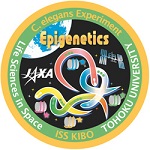This is an archive of information released in the past.
Disclaimer: It may contain broken links or outdated information. Some parts may not function in current web browsers.
*Visit https://humans-in-space.jaxa.jp/en/ for the latest information.

Generations in space

Materials for a biology experiment mission named "Epigenetics" were among the payloads of the Dragon spacecraft which was launched for the ISS by the Falcon 9 rocket on January 10th, 2015.
The purpose of the experiment, planned by Professor Atsushi Higashitani of Tohoku University, is to ask if any stable modifications in traits other than mutations, changes in DNA sequence, arise through successive generations of living organisms in space. The results are expected to help understanding the adaptation mechanism to space environment and developing technologies for longer stay in space. Model organisms with very short generation time are suitable for this experiment. A tiny non-parasitic roundworm, Caenorhabditis elegans, is ideal for the purpose.
C. elegans is widely used in biological and medical researches. It has a lifespan about 2-3 weeks and a generation time about 4 days at 20℃. The first generation of worms in space is cultured in a bag containing liquid media and bacteria as their food. Four days later, baby worms are born. The adult worms, about 1 mm in length, are filtered out and much smaller baby worms were then transferred to a new bag. The second generation grows up and the third generation of baby worms is born 4 days later. Similar procedures are repeated to produce the fifth generation. The worms of all generations are frozen and brought back to the ground for detailed analyses. Some worms of the fourth and fifth generations are further cultured on to leave offspring that are compared to generations in space. Any modified trait found is examined whether it is due to mutation or epigenetic modification.
The gene expression process, in which functional gene products are synthesized based on genetic information or DNA sequence, is regulated by complex and precise mechanisms. Epigenetic modifications are alterations in the gene expression regulation. Stable chemical modifications on DNA or on its associated protein, such as histone, molecules affect cellular capability of gene expression. The gene expression is also regulated by micro RNA, transcription products from non-coding regions of DNA. The epigenetic regulations play important roles in physiological processes such as development, differentiation, adaptation to environment and ageing.
The samples returned to Earth on February 12th by the Dragon spacecraft. What happened to the worms and their gene expression activities? The results are waited.
| Copyright 2007 Japan Aerospace Exploration Agency | Site Policy |
